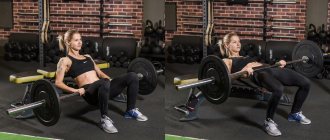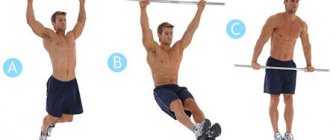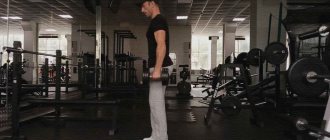Splits for beginners may seem like a difficult element that many people are reluctant to attempt. However, like any physical exercise, after hard training you will be able to do the splits, even if you are not naturally flexible.
What kind of splits are there?
Gymnastics and acrobatics include various types of splits. Some you can learn in a couple of months of hard training, while others will take six to a year to master.
Twines are divided into several main types:
- Longitudinal
- Transverse
- Classical
- Provesny
- Horizontal
- Vertical
- Half twine
Let's take a closer look at each of them.
Cross twine
The essence of the cross split is to spread your legs to the maximum angle in different directions. Even despite training, some people, due to their physiology, will not be able to perform this element - the problem lies in the structure of the pelvis, which does not allow the body to take this position. By the way, it is easier for men to master cross splits than for women - women's hips are not well suited for such exercises.
Longitudinal twine
With a longitudinal split, the legs are spread in two directions - forward and backward. A correctly taken position forms a longitudinal line in the direction of the legs.
Here, unlike the cross split, women have a slight advantage - men have a powerful back of the thigh, which is quite difficult to develop for the longitudinal split.
Classic twine
This element comes from acrobatics. The exercise consists of positioning your legs so that the angle between the inner surfaces of your thighs is one hundred and eighty degrees.
Hanging twine
This version of the twine must be done especially carefully; it will require remarkable flexibility. You need to start the exercise standing on a support and gradually sitting down on the splits, as shown in the picture below. After taking the correct position, it turns out that the angle between the legs is more than 180 degrees, since one of them is on a support. That is why this option is called “suspended”.
Horizontal twine
Based on the name, the legs should be directed in different directions along the horizon line.
Vertical twine
The vertical version of the twine is best done with a support that you can hold on to with your hands - it will be easier and safer. The legs are spread from a standing vertical position, one leg is raised vertically up, perpendicular to the floor.
Half twine
The half split is a good preparatory exercise for the full split version. It will take several training sessions to complete it. Sit on the floor, bend one leg as far as possible toward you, and extend the other back. Lock yourself in this position and stretch your body towards your extended leg.
Warm-up before the splits
To do the splits without injury, you need to warm up your muscles; to do this, perform a set of exercises that are described below.
Butterfly
This exercise is aimed at stretching the thigh muscles, especially the inner part. It also increases the flexibility of the inguinal ligaments, which play an important role in the splits.
Sit on the floor, bend your legs and bring your feet together, pulling your heels towards you, as shown in the picture. Place your hands on your knees and try to press them into the floor. Your back should be straight and you should not feel any pain. If there is no discomfort, try to stretch both arms and stretch your whole body forward.
Frog
This type of warm-up exercise is particularly good at stretching the inguinal ligaments and inner thighs. Take the starting position - lie on your stomach on the floor. Spread your legs in different directions, bend your knees. Press your feet together so that your body forms a “P”. Try to hold this position for several minutes, then slowly bring your feet together, keeping your pelvis on the floor.
Floor socks
This exercise strengthens and stretches the thigh muscles, ligaments in the groin and behind the knee. Go to the wall and lie on your back. Raise your legs up, pull your body towards the wall. Start spreading your legs in different directions, carefully, without sudden movements. Move to the maximum distance, lock in this position for several minutes. Return to the starting position also slowly and carefully, without jerking.
Cross split stretch
The transverse split is considered more difficult to master than the longitudinal split, which is due to the unnaturalness of this position for everyday life. The cross split stretch requires a high level of flexibility of the adductor muscles, development of the hip joints and good elasticity of the tissues surrounding them.
In our selection you will find the best exercises that will help you develop flexibility from scratch. To perform this you will need a mat and yoga blocks. Instead of yoga blocks, you can use volumes of books.
What is important to know:
- Be sure to warm up before doing the splits. Without warming up, stretching into splits is not only ineffective, but also fraught with injury.
- Stay in each pose for 1 minute. You can gradually increase the time and try to deepen the position to develop flexibility.
- If you want to quickly do the cross splits, train 5-6 times a week for at least 30 minutes. How quickly you can do the cross split depends on your natural abilities and efforts during training.
- Sitting on a transverse split is usually more difficult and takes longer than doing a longitudinal split. Therefore, you can first achieve one goal - to sit on the longitudinal split, and only then move on to mastering the transverse split.
- If you want to stretch with both the longitudinal split and the cross split, you can alternate the two exercise plans every other day.
Squat plie
Place your feet as wide apart as possible and point your toes out to the sides. From this position, squat with your back straight, lowering yourself until your thighs are parallel to the floor. Place your elbows on your hips or bend your body while clasping your knees with your hands. Do not move your pelvis back or bring your knees together while holding the plie. The exercise effectively prepares for a deeper load, toning the legs and gently stretching the adductor muscles of the hips.
Simple option:
Difficult option:
Fold with wide stance
Place your feet as wide apart as possible and lean down with your back straight, trying to reach the floor. Arch your lower back, leaning from your hips. Spread your legs as far as possible to place not only your palms on the floor, but also your elbows. The fold opens up the hip joints, increases range of motion, stretches the muscles of the inner thighs and increases the elasticity of the ligaments and tendons, which will help you do the cross splits at home in the future.
Simple option:
Difficult option:
Tilt with leg girth
Remaining in the same position with your legs wide, lean towards your right leg, trying to lie on it with your whole body, then towards your left. Then clasp your legs with your hands and lower your head down, trying to place the top of your head on the floor. A more complex version of the fold works the muscles of the inner thighs more deeply, opens the hip joints and increases their mobility, and also helps to activate blood circulation in the pelvic organs, which is beneficial for women's health.
Twisting the body in an inclined position
With your feet slightly wider than shoulder-width apart, lower your arms down, keeping your back straight. Now lift your right hand off the floor and turn your body to the right, feeling the stretch in the muscles of your left thigh. Then twist to the left to stretch your right hip. The exercise gently stretches the hips and sides of the body, elongates the spine and improves body flexibility, and also serves as an excellent cross-split stretch at home for beginners.
Side Lunge Stretch
Place your feet as wide as possible and bend your right knee, lowering your pelvis downwards, keeping your left leg fully straight. Try to sit as close to the floor as possible, stretching your inner thighs. Repeat with the other leg. A basic exercise of stretching for transverse splits develops flexibility of the legs, opens the hip joints and well stretches the adductor muscles of the hips, and also makes the ligaments and tendons elastic.
Simple option:
Difficult option:
Elevated Side Lunge
While remaining in a side lunge, place your straight leg on a chair; choose the height of the chair depending on the level of stretching (the higher the chair, the more difficult it is to stretch). Bend toward your straight leg or simply hold it tense, feeling the thigh muscles stretch. Repeat for the other leg. This exercise will help deeply stretch the leg muscles, opening the hip joints and preparing the body for the cross split.
Yoga squat
Place your feet slightly wider than your shoulders and point your toes out to the sides. Lower yourself into a deep squat, bending your knees completely. Place your palms together and spread your elbows out to the sides, resting them on your knees and applying slight pressure to deepen the stretch. Keep your back exactly in the same plane as your hips. An excellent exercise for opening the hip joints, stretching the gluteal muscles and inner thighs.
Seated knee extension
Sit on the floor and bend your knees. Spread your knees as far apart as possible so that they are in the same plane as your body. Place your hands on your shins, turn your toes to the sides. Keep your back straight, without leaning forward or bending at the waist. The exercise is suitable for doing split stretches at home for beginners, as it deeply stretches the muscles of the inner thighs, increasing the flexibility of the legs.
Seated frog pose
Sit on your knees and rest on your heels. Now spread your knees to the sides, trying to sit completely on the floor so that your shins are on the sides of your body. If you succeed, twist your body left and right to increase the stretch and gently stretch your spine. The more you open your knees, the stronger the stretch, so ideally try to close your feet behind you. The exercise is suitable for gentle stretching of the hips and is especially effective for beginners.
Seated leg abduction
Sit on the floor and spread your legs to the sides. Bend one leg at the knee and pull your foot towards your body as close as possible. The other leg remains straight and freely extended to the side. Try to move your straight leg as far from the center as possible to increase the load. Repeat with the other leg. Another gentle stretch for the inner thighs that is perfect for beginners.
Side bend while sitting
To complicate the previous exercise, tilting the body towards the straight leg will help. To do this, stretch your right leg to the side and lean towards it with your whole body, trying to clasp your foot with your left hand. Place your right one freely in front of you. Repeat the bend on the other side. The exercise not only stretches the sides of the body, but also increases the load on the thigh of the straightened leg, promoting deep stretching of the adductor muscle.
Half lotus stretch
Sit on the floor and cross your legs as comfortably as possible. Bring one leg back without straightening the knee, leave the other as is. Maintain this position until you feel a stretch in your inner thigh muscles, then repeat on the other leg. A simple exercise will gently stretch your hips, increasing the mobility of joints and the elasticity of ligaments, and will also help you quickly do the splits in the future if there is no stretching.
Bend over with crossed legs
Sit on the floor and cross your legs in lotus position or do a simplified version. Stretch your arms forward, trying to lie on the floor with your entire body. If it doesn’t work, then lean on your forearms and fix the position. The exercise gently stretches the adductor muscles of the hips, but it is important to remember that the leg that is higher or in front is stretched more, so do not forget to change their position.
Simple option:
Difficult option:
Butterfly sitting
Remaining in a sitting position, bring your feet together and spread your knees out to the sides. Grasp your feet with your palms, pulling them as close to the body as possible. Keep your back straight, do not round your lower back. To enhance the stretching, lean forward, trying to lower your whole body to the floor, but if that doesn’t work, stretch until you feel tension in your thigh muscles. The butterfly stretches the adductor muscles of both legs well, opens the hip joints, improving their mobility and flexibility.
Simple option:
Difficult option:
Lying frog pose
Get on all fours with support on your forearms and lower your body down, while simultaneously spreading your knees to the sides. If you can’t lie on the floor, then maintain a comfortable position, trying to spread your knees as wide as possible to get as low as possible. One of the best exercises, the correct execution of which will bring you closer to the cross splits. Here the hip joints are almost in a split state, and the leg muscles are stretched to the maximum, which increases the flexibility of the legs and the whole body.
Frog Pose with Straight Leg
From Full Frog Pose with Belly on the Floor, straighten one leg and hold the position. Then change legs. If you can’t lie with your body on the floor, place a mat under your knee and, holding yourself on straight arms, move your leg as far as possible, trying to straighten it completely. Lower your leg lower each time, which will help you get into the cross split. The exercise deeply stretches the thigh muscles, opens the hip joints, and improves the elasticity of ligaments and tendons.
Simple option:
Difficult option:
Lying Butterfly Pose
Lie on your back and bend your knees. Place your feet together and spread your knees out to the sides. Place your palms on your thighs and press down on them, lowering them lower, but avoid sudden movements to avoid injury. Try to place your feet as close to your body as possible, and spread your knees as far as possible, bringing them closer to the floor. A simple and effective exercise will improve your stretching, helping you do the splits at home.
Knee to body lying down
Staying on your back, straighten your legs. Bend one leg at the knee and clasp its foot with your hands. Turn your shin 90 degrees and pull it towards you. Repeat with the other leg. This simple exercise stretches the gluteal muscles, but with maximum rotation of the shin towards the body, it provides a deep stretch of the hip adductors, which increases the flexibility of the legs and brings you even closer to a full cross split.
Lying leg abduction
Beginners may want to skip this exercise due to its difficulty. Lying on your back, stretch your legs straight. Raise your right leg, bring it towards your body and move it to the side, lowering it as close to the floor as possible. Repeat with the other leg. Mastering this exercise will help you quickly do the transverse split at home and improve stretching in the longitudinal, as the inner thigh muscles are deeply stretched here and the range of motion of the hip joint increases.
Spreader
Lying on your back, lift your straight legs up and spread them to the sides. Help yourself with your hands to lower your legs closer to the floor, but do not overdo it to avoid injury. This exercise makes good use of the adductor muscles, which come into play when the legs are lowered under their own weight in the step. In addition, the cross-leg is almost a transverse split, only in inversion.
Side leg spread
Lie on your right side and lean on your forearm. Lift your left leg up, bringing it towards your body. Help yourself with your hand to pull your foot as close to you as possible. Do not bend your leg at the knee, pull it until the muscles of your thighs are tense. Then switch legs. A simple exercise will help you develop flexibility in your legs and quickly do the splits if you don’t have stretching, provided you do regular stretching.
Cross split with forearm support
Place a yoga block in front of you and rest your hands or elbows on it. Spread your legs as wide as possible, trying to get as low as possible. To intensify the stretch, sit on the floor, spread your legs as wide as possible and lean forward, resting on your forearms. In the future, try to lie on the floor with your body stretched out in front of you. Deep stretching of the inner thigh muscles will be the last step in mastering the cross split.
Simple option:
Difficult option:
Incline in cross split
Bends to the sides will help increase the stretch in the cross split. To do this, sit on the floor and spread your legs as wide as possible. Bend your whole body towards one leg, then towards the other, fixing the position. You can also perform a side bend on each leg to further stretch your core. Not only does it engage the muscles of the hips and pelvis, but it also stretches the spine and sides of the body, which improves the overall flexibility of the body.
Butterfly near the wall
Lie on your back with your feet on the wall. Get close to the wall, then bring your feet together and spread your knees out to the sides. Place your palms on your thighs or knees, pressing lightly on them to lower them. This exercise stretches the inner thighs, but also relaxes the lower back, improves blood circulation in the pelvic organs and prepares for higher loads.
Stepping against the wall
From a butterfly position against the wall, straighten your legs and spread them apart. Use your hands to help lower your hips even lower to the floor. The wall-supported stretcher allows you to lower your legs as much as possible, stretching the adductors and opening the hip joints well, which increases their range of motion. As a result, you prepare your body for a full split. This is one of the best exercises to quickly do the cross splits: you can lie in this position against the wall for quite a long time, deepening the stretch.
Cross split with support on the forearms
The final stage will be a cross split with support on your hands. To do this, place your elbows on the floor and spread your legs to the sides, trying to almost lower yourself to the floor. But under no circumstances sit down suddenly, so as not to injure yourself. Lower yourself to the minimum distance from the floor, reducing it each time. So you will soon completely fall into the splits and finally make your dream come true.
See also our other stretching selections:
- Top 40 Full Body Exercises for Men or Beginners
- Top 10 Exercises for Stretching the Pectoral Muscles
- Top 10 Quadriceps Stretch Exercises
- Top 10 Butt Stretch Exercises
- Top 20 Back Stretch Exercises
- Top 20 Hamstring Stretch Exercises
Twine stretch
Basic exercises that are aimed at improving muscle elasticity, strengthening joints and stretching ligaments.
Lunge
Bend one leg at the knee, lower your body closer to the floor, moving the other leg back. Lean on the foot of your other leg, pull your pelvis towards the floor. Your arms can be raised up or placed on your knees.
Pigeon
Sit on your knees, then take one leg back, bend the other at the knee and throw it forward. Your body weight should be on your front leg, with your hands on the floor. If the exercise is easy, you can increase the load by placing your chest on the calf of your extended leg.
Knee Lunge
Take the same position as in the “Lunge” exercise. Bring your hands to your front leg, place your back leg on the floor so that your knee touches it. Straighten your back, place your hands on the pelvic area, bend slightly back.
Exercises that improve stretching of the hips and legs
We list the most popular poses for passive stretching:
- transverse and longitudinal lunges - in the first case the impact falls on the adductors, in the second - on the quadriceps;
- longitudinal fold (knees together) - stretches the hamstrings, calf muscles (toes pointing towards you);
- transverse (lower limbs widely spaced) - emphasis is placed on the adductor muscles (inner thighs);
- pigeon pose (reminiscent of a longitudinal split, but the front leg is bent at the knee, the lower leg is moved inward) - the buttock stretches;
- butterfly (sitting position on the floor, knees bent and apart, feet together) - stretching occurs in the groin area, increasing the eversion of the hip joints, which is especially important for athletes over 30 years of age;
- frog - (on all fours with hips apart and lowered) - the action is similar to the previous pose;
- bending - this simple exercise allows you to stretch the hamstrings, gluteal muscles, and increase the mobility of the hip joint.
For dynamic stretching, the most popular are swings. They are performed standing on one leg, the other is set in motion. Due to inertia and increased amplitude, the muscles and ligaments of the thighs stretch better each time, bringing you closer to the splits. Also, do not forget to rotate your head and arms, paying attention not only to the groin area, but also to other parts of the body.
How long to train to do the splits?
The time it takes to fully master the exercise depends on perseverance, the physiological characteristics of the body and the amount of training.
If before this a person was engaged in gymnastics and regularly did stretching exercises, then the splits can be mastered in one to two months. If there is no such experience, much more time is needed.
Physiology in your 20s can significantly impact the time it takes to achieve your goal, both positively and negatively. Gender also plays an important role - it will take men from six to ten months to do the splits from scratch. This happens because stretching muscles and ligaments is much easier for women than for men.
Do not forget that twine has some contraindications. You cannot perform the exercise if you have:
- Problems with the spine;
- Osteoporosis;
- Osteochondrosis;
- Pathologies and chronic diseases associated with the circulatory system;
Tips on how to do the splits faster
These tips will help you learn the splits faster.
- The elasticity of muscles and skin depends on the amount of water consumed by a person. It will be a little easier to do the splits if you regularly drink the required amount of liquid;
- It is not recommended to do stretching exercises and do the splits when you are feeling unwell, have an exacerbation of some disease, or have a critical period;
- A hot shower before training will help warm up and improve the elasticity of the muscle system and skin;
- A short massage before starting a workout will be helpful;
- Eat right: in the morning - complex carbohydrates and fiber, at lunch - protein and fats, and in the evening for dinner - quickly digestible carbohydrates;
- Along with stretching, do running exercises and cardio training. This will help strengthen muscles, prepare the body for stress, and improve blood circulation.
Why do the splits?
If you think that splits are needed only to have a beautiful and flexible body, then you are deeply mistaken.
- Benefits health;
- Strengthens the abdominal muscles;
- Relieves tension;
- Reduces injuries during sports;
- Increases muscle elasticity, resulting in improved recovery after strength training;
- Normalizes blood circulation.









